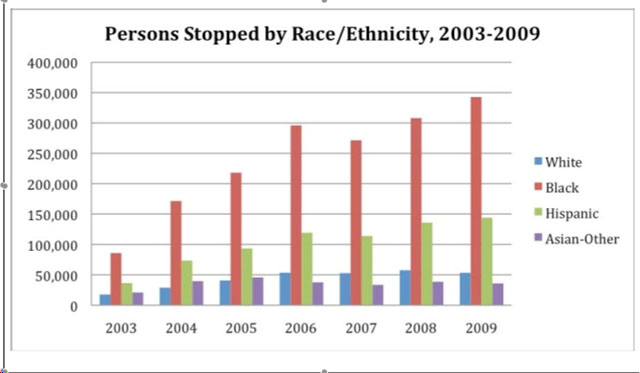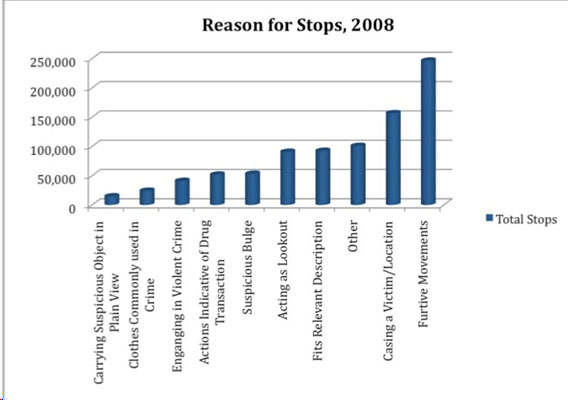Learning Objectives
- Students will learn about the "Stop and Frisk" policy, including background information and important data on the policy and practice in NYC.
- Students will form their own opinions about Stop and Frisk and be able to articulate them.
- Students will be able to summarize articles with different points of view on Stop and Frisk.
Review Learning Objectives and Agenda
Warm-up (10 min)
Ask students (by a show of hands) if they have ever been accused of something they didn't do, or if someone has ever been "suspicious" of them or their intentions.
Have students pair up and respond to the following with their partner (2 minutes each): Share a time you were accused of something you didn't do or a time when someone was suspicious of you for no apparent good reason. How did you feel? After the pairs have discussed their stories, have a few students share with the whole class.
What is Stop and Frisk? (10 min)
"Stop and Frisk" is a police action to momentarily detain and search the body of a person. Under judicial interpretation of the Fourth Amendment to the United States Constitution, such a search may be conducted only under circumstances where the officer believes that the person is armed and dangerous to the officer's person, or that the person has just committed or is about to commit an unlawful act.
Share the background below, or have students read it:
The U.S. Supreme Court established a legal basis for officers to stop, question, and frisk citizens in its 1968 decision in the case of Terry v. Ohio. In the Terry case, a veteran police officer observed three men engaging in conduct that he concluded might be indicative of "casing" a store, that is, preparing to commit a robbery. When he approached the men to ask them questions, the response from one of them was incoherent. Fearing that the men might be armed, the officer grabbed hold of one of them and "patted" him down. The pat-down revealed that the man was carrying a gun.
The Terry decision permits police officers to stop and detain a person based on a "reasonable suspicion" that s/he might be about to commit a crime or is in the process of committing a crime. It represents a modification of the Fourth Amendment protection against unreasonable searches and seizures granted to private individuals in the Bill of Rights. Prior to Terry, police officers were required to have a higher level of proof, "probable cause," before interfering with the liberty of private persons. Terry stops, as these encounters have come to be called, may be conducted based on far less evidence than that legally required to justify an arrest, but they may not be conducted based on groundless hunches about specific individuals being involved in crime.
On August 12, 2013, a federal judge ruled that the NYC Police Department's stop and frisk policy violated the constitutional rights of blacks and Latinos in the city. The judge, Shira A. Scheindlin, found that police had resorted to a "policy of indirect racial profiling," increasing the number of stops in black and Latino communities. She ruled that under the policy, officers routinely stop "blacks and Hispanics who would not have been stopped if they were white." Scheindlin called for a federal monitor to oversee broad reforms, including the use of body-worn cameras for some patrol officers, but said she was "not ordering an end to the practice of stop-and-frisk." For more information, please see Joseph Goldstein's article in the New York Times.
Opinion Continuum (10 min)
Read the following statements one at a time and have students decide if they agree (thumbs up), disagree (thumbs down), or are not sure or have mixed feelings/thoughts about it (thumbs to the side). Ask a few students to share their points of view on each statement.
1. Stop and Frisk makes people feel more safe.
2. Stop and Frisk violates people's civil rights.
3. Stop and Frisk gets guns off the streets.
4. Stop and Frisk targets black and Latino young men.
5. Stop and Frisk reduces crime.
Background Information and Data (10 min)
Share the following background information and data on Stop and Frisk.
- The number of stops from 2002-2009 increased more than five times from 97,837 in 2002 to 576,394 in 2009 (see graph).
.jpg)
- For each year 2003 through 2009, Blacks and Latinos make up a substantial majority of persons stopped. In 2009 alone, Blacks and Latinos combined were stopped 9 times more than whites. Overall, 87% of those stopped by the NYPD in 2011 were black or Latino (see graph).

- The top reasons for stops include "furtive movements" and "casing a victim or location (see graph).

- Many people stopped by police officers in NYC are questioned and then permitted to move on, but many are also "frisked," and a significant number experience the use of force beyond the frisk itself. During roughly half of all stops in 2008 (54.40% or 293,934 stops), officers reported frisking the suspect. Officers are legally authorized to pat down the outer clothing of a suspect to determine if the person is carrying a weapon.
- In roughly one quarter of stops in 2008 (23.60% or 127,516 stops), officers used some form of force beyond the pat down. According to information captured in completed UF-250 forms, the categories of force included putting suspects on the ground or against a wall; drawing a weapon and/or pointing a weapon at the person stopped; and using manual force, a baton, handcuffs, or pepper spray during the stop.
- 1.24% of total stops resulted in the discovery of a weapon of any kind (gun, knife, or other type of weapon).
- Out of 540,320 total stops in 2008, 6% (32,206 stops) resulted in an arrest, and 6.40% (34,802 stops) resulted in the issuance of a summons, for a combined total of 12.40%. The percentage of stops that resulted in an arrest or summons during 2008 is similar to outcomes in the previous five years (2003-2007), when the proportion of stops that resulted in an arrest or a summons ranged from a high of 13.13% (2003 and 2007) to a low of 9.88% (2006).
- A 2012 NYPD study shows NYC homicides for the year dropped to a record low. In Mayor Bloomberg's first year in office in 2001, the murder rate was 649. In 2012, it was 419. NYPD credits the controversial Stop and Frisk with the decline in violence.
Engage students in the whole class discussion by asking:
- Is there anything that surprises you about the information?
- What was something new you didn't know before?
- What did you already know?
- What do you think about Stop and Frisk? Has your view of it changed based on what you have learned so far?
- What other questions do you have?
Video Clip and Discussion (5 min)
Show this 5 minute video clip from Reuters, "Stories of Stop and Frisk"
Afterwards, ask students:
- What was the point of view of the video?
- What points do you agree with? What do you not agree with?
- What evidence did the video use to make its points?
- How did you feel while listening to people talk about their experience with Stop and Frisk?
Point of View/Reading Activity (15 min)
Distribute the two articles below, each with a different point of view on Stop and Frisk. Give half the students one article and the other half the other article.
- Pro Stop and Frisk: https://www.nytimes.com/roomfordebate/2012/07/17/does-stop-and-frisk-reduce-crime/dont-antagonize-those-who-could-help-fight-crime
- Anti Stop and Frisk: https://www.nytimes.com/roomfordebate/2012/07/17/does-stop-and-frisk-reduce-crime/to-see-its-value-see-how-crime-rose-elsewhere
After reading the articles, have a few students give a summary of the article they read, the main idea, point of view expressed, and anything new they learned. Engage students in whole class discussion by asking:
- How did the article make its case for or against Stop and Frisk?
- What points did you agree with. What did you disagree with?
- Did the article change your point of view? If so, how?
Closing (5 min)
Have students think about one thing they learned today. Share a few responses aloud.
Extension Activities
WRITING: Write an op-ed or letter to the editor with your point of view on stop and frisk, including evidence, data, quotes, etc. to support your opinion.
MATH: Create an opinion poll to distribute in your school and/or community that asks people's thoughts and feelings on Stop and Frisk. Distribute the survey, collect responses, and analyze the results.
RESEARCH: Conduct research on larger issues of racial profiling and disproportionality in the criminal and juvenile justice systems. Write a research report that cites evidence, data, and relevant quotes.
ART/MEDIA: Select a point of view on Stop and Frisk and create a public awareness campaign about it, using video for a PSA, infographics, posters, and/or social media (Facebook, Tumblr, etc.) to illustrate your point of view.
Common Core ELA Anchor Learning Standards
Reading
R.1 Read closely to determine what the text says explicitly and to make logical inferences from it; cite specific textual evidence when writing or speaking to support conclusions drawn from the text.
R.2 Determine central ideas or themes of a text and analyze their development; summarize the key supporting details and ideas.
Writing
W.1 Write arguments to support claims in an analysis of substantive topics or texts using valid reasoning and relevant and sufficient evidence.
W.9 Draw evidence from literary or informational texts to support analysis, reflection, and research.
Speaking and Listening
SL.2 Integrate and evaluate information presented in diverse media and formats, including visually, quantitatively, and orally.
SL.4 Prepare for and participate effectively in a range of conversations and collaborations with diverse partners, building on others' ideas and expressing their own clearly and persuasively.
Vocabulary
- Enforcement
- Profiling
- Humiliating
- Deterrence
- Assault
- Assertive
Resources
- Stop, Question & Frisk Policing Practices In New York City: A Primer, John Jay College of Criminal Justice, March 2010
- Stop-and-Frisk Campaign: About the Issue, New York Civil Liberties Campaign
- Room for Debate: Does ‘Stop and Frisk' Reduce Crime, New York Times, 7/17/12
- Translating Stop, Question, and Frisk Numbers into Neighborhood Impact, Vera Institute of Justice, Winter 2012-13 (no longer accessible)